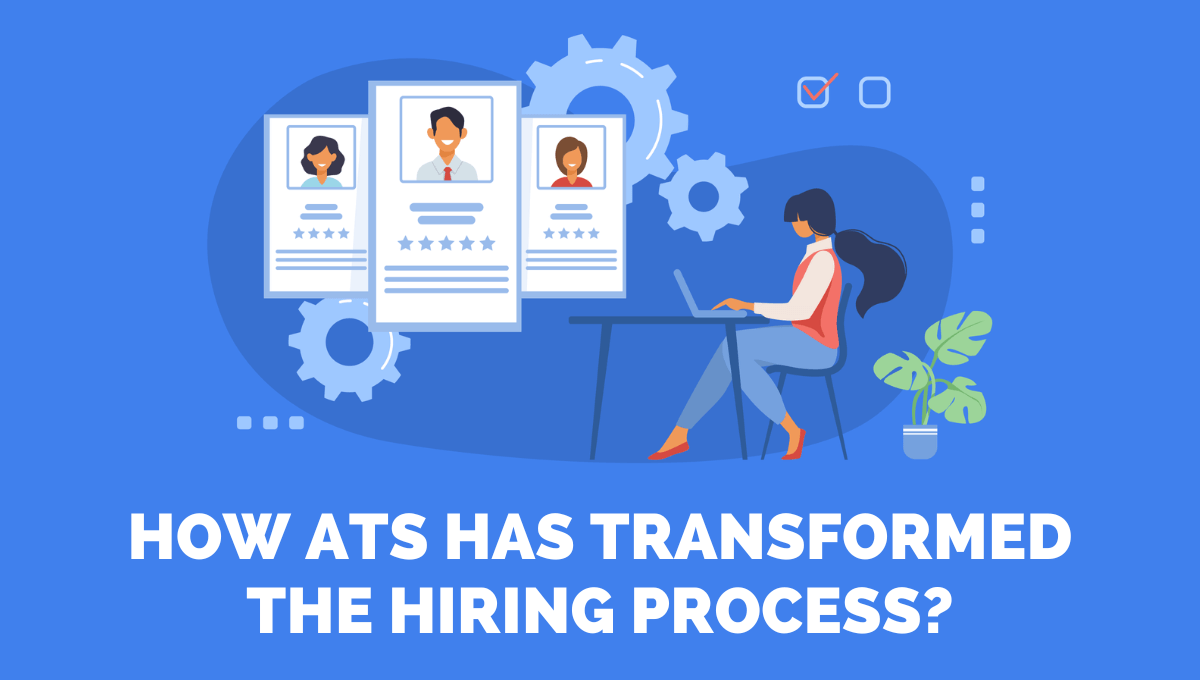Applicant Tracking System is a software program used by recruiters to efficiently manage the hiring process. The emergence of the Applicant Tracking System( ATS) has revolutionized the recruitment process by offering a much-needed solution to streamline hiring. Around 90% of companies leverage ATS to manage their workflow.
ATS acts like digital assistants that help in sorting resumes, scheduling interviews, and keeping track of applicants. They can scan resumes for keywords related to the job description, filtering out unqualified applicants and prioritizing the most relevant ones. This helps recruiters save time by focusing on the most promising candidates.
Additionally, with CRM integration, ATS software can build a talent pool of qualified applicants who might be a good fit for future opportunities. With so many capabilities, ATS is definitely going to be the game changer for your recruitment drive. Before implementing one, let’s dive into the features offered by the Applicant Tracking system.
Key Features of Applicant Tracking System
Every Applicant Tracking System provides different functionalities. For example, some will help you source candidates while others will allow you to automate scheduled interviews. Here are a few key features of the ATS.
1: Streamlined Job Posting and Advertising
Traditionally, posting jobs involved manually entering details on various job boards. With ATS integration, you can create a single master job posting within the ATS. This master posting can then be automatically distributed to multiple job boards with just a click. This saves recruiters a significant amount of time and ensures consistency across all posts.
2: Resume Screening and Parsing
Various candidates make different resumes and often arrive in various formats, making it difficult to quickly scan for relevant skills and experience. ATS uses technology to automatically extract key information from resumes. This “parsing” can turn resumes into organized data within the ATS, allowing you to search and filter based on specific criteria like skills, or key roles.
3: Applicant Filtering and Searching
With the information extracted from resumes, the ATS allows you to filter and search your applicant pool in a much more targeted way. This helps recruiters to quickly identify applicants who meet these requirements, saving you time sifting through irrelevant applications.
4: Candidate Pools and Tagging
Once you’ve identified promising candidates, the ATS allows you to organize them into different pools based on their qualifications and how far they’ve progressed in the hiring process (e.g., initial screening pool, interview shortlist). You can also use tags to further categorize candidates based on specific skills or interview feedback. This level of organization makes it easier to track the progress of each applicant and collaborate with hiring teams on the selection process.
5: Automated Email Communication
As a recruiter, you can set up email templates within the ATS that automatically send updates to candidates based on their application stage (e.g., application received, interview invitation, offer letter). This saves recruiters a significant amount of time and ensures all candidates receive consistent communication.
6: Internal Communication Tools
The recruitment process often involves collaboration between recruiters, hiring managers, and other team members. An ATS can provide internal communication tools like chat functionalities or discussion boards. This allows recruiters to share candidate profiles, interview feedback, and notes with the hiring team in a centralized location.
7: Scheduling Integrations
Many ATS systems integrate with popular calendar applications. This allows recruiters to propose interview slots to candidates directly within the ATS, and the system automatically checks for conflicts with the interviewer’s schedule. This eliminates the need for lengthy email exchanges and ensures a smoother interview scheduling process for both candidates and recruiters.
How ATS has Enhanced The Recruitment Process?
1: ATS Functioning AS CRM
Modern Applicant Tracking System (ATS) goes beyond simply managing the application flow. They act as a powerful Candidate Relationship Management (CRM) tool as well. By capturing and storing candidate information in a central database, the ATS creates a rich talent pool that recruiters can leverage for future opportunities.
This managed database offers a significant advantage. Recruiters can quickly screen resumes based on specific skills and experience, saving them valuable time and effort. Having a pre-qualified pool of candidates also allows for a smoother hiring process. It allows recruiters to readily identify potential matches for new openings.
2: Monitors The Recruitment Process
ATS hasn’t only helped in faster resume parsing but it also plays a crucial role in monitoring the entire recruitment process. It centralizes candidate data, providing detailed analytics on metrics like team, activity log, time-to-hire, cost-per-hire, and identifying effective recruitment channels. They streamline communication, ensure compliance, and automate resume screening to quickly identify top candidates.
How ATS Has Impacted Recruiting Professionals?
Applicant Tracking System (ATS) has significantly reshaped the role of recruiters, transitioning them from administrative tasks to more strategic functions that emphasize relationship-building and candidate engagement. Here’s how ATS with CRM functionalities has driven this transformation, supported by relevant statistics:
1: Reduced Administrative Burden
ATS automates multiple repetitive administrative tasks involved in recruitment, such as job posting, resume parsing, and interview scheduling. This trend will further increase. It’s backed by a survey from CareerBuilder that states 72% of employers expect that talent acquisition will be fully automated by 2027.
2: Enhanced Data-Driven Decision Making
ATS provides recruiters with detailed analytics and insights, enabling them to make decisions by data-driven information. This shift allows recruiters to identify trends, measure the effectiveness of various recruitment channels, and optimize their strategies. For instance, LinkedIn reports that 69% of recruiters believe that using data can improve the recruitment process, particularly in sourcing and hiring decisions.
3: Improved Candidate Engagement
With the reduced administrative load, recruiters can dedicate more time to engaging with candidates, building relationships, and enhancing the candidate experience. A survey by Jobvite found that recruiters who use ATS spend 20% more time engaging with candidates than those who do not use such systems.
4: Strategic Talent Acquisition
Applicant Tracking System (ATS) enables recruiters to adopt a strategic approach to talent acquisition by focusing on long-term goals such as building talent pipelines and enhancing employer branding. ATS facilitates the creation of talent pipelines through efficient candidate database management, ongoing engagement tools, and insightful analytics. It enhances employer branding by ensuring consistent and positive communication, optimizing the candidate experience, and integrating with social media. By automating administrative tasks, ATS allows recruiters to proactively plan for future hiring needs and effectively communicate the organization’s values, ultimately attracting and retaining top talent.
5: Improved Client Management
ATS integrated with CRM (Customer Relationship Management) capabilities enhances client management. Recruiters can build and maintain relationships with past, current, and potential future candidates, gaining a deeper understanding of their skills and preferences. This integration keeps candidates engaged through personalized communication and timely updates, leading to more effective and efficient recruitment processes. It ultimately results in better client satisfaction.
Future Outlook
The future of the Applicant Tracking System (ATS) looks promising. These advancements can change the pace and process of recruitment. Here are some key areas to watch:
- Enhanced AI Capabilities: The integration of AI in ATS is already becoming a game changer, but we can expect it to become even more sophisticated further. Machine learning algorithms will become adept at understanding complex skills and experience, leading to more nuanced candidate assessments and reduced bias.
- Integration with Skills Assessments: ATS could seamlessly integrate with online skills assessment assignments, providing a more objective measure of a candidate’s abilities beyond just their resume. This could be valuable for roles requiring specific software proficiency.
- Focus on Diversity and Inclusion: AI-powered ATS features can be designed to mitigate bias in the hiring process. By analyzing language and focusing on skills over subjective criteria, ATS can help ensure a wider range of qualified candidates.
- Personalized Candidate Journeys: ATS can tailor the application process to each candidate. This could involve targeted communication, automated interview scheduling based on candidate availability, and progress updates throughout the hiring process. This would create a more positive experience for qualified candidates, even those who aren’t selected further.
- Improved Ability To Leverage Social Networks: Social networks (i.e. LinkedIn) play a crucial role in the recruitment process. ATS integrated with these platforms helps recruiters to look for top-notch passive and active candidates.
- Cloud-Based Ecosystem: The future of ATS is going to be heavily reliant on the cloud-based ecosystem eliminating the need for on-premise maintenance. Leading ATS will be integrated with a broader technology stack, allowing employers to better understand the ways in which recruiting processes impact the business.
Conclusion
Applicant Tracking System (ATS) has become an indispensable tool in today’s competitive recruitment landscape. As per Capteraa, 94% of recruiters agree it positively impacts their hiring process. However, traditional ATS systems can have limitations.
This is why you should choose Smoothire. It goes beyond a regular ATS by incorporating Customer Relationship Management (CRM) functionalities. This means it not only streamlines the application and hiring workflow but also builds a robust talent pool by intelligently storing candidate information from resumes. This comprehensive approach gives recruiters a significant edge.
As technology continues to advance, we can expect even more exciting developments in ATS, creating a future where the hiring process is efficient, fair, engaging, and focused on finding the perfect fit.



